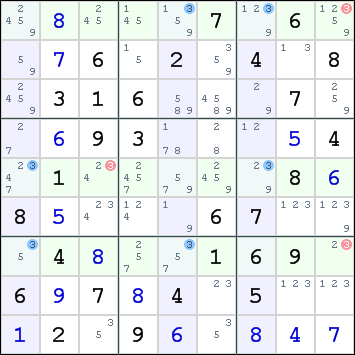Fish and Subsets
Fish and Subsets are complementary to each other. One can transform a problem of finding a fish into a problem of finding a subset, and vice versa.
Contents
Trawling for Fish Using Locked Sets
It may be difficult to spot a fish in a pencilmark grid, especially Swordfish, Jellyfish, or Squirmbags. But the analysis and discovery of basic fish (X-Wing, Swordfish, Jellyfish, Squirmbag) can be made easier by mapping the fish problem onto a Locked Set problem. Here is the procedure for analyzing a row-based Swordfish:
- Make a list of 9 sets, each one corresponding to a row in the Sudoku. Populate each set with the column numbers of each column within that row that has the digit for which we're searching for a basic fish.
- Examine the sets, looking for a locked triple--a group of three sets containing only the same three numbers.
- If you find such a locked triple, you have netted a Swordfish! The digits in the locked triple are the column numbers in the Swordfish.
For a column-based Swordfish, swap "row" and "column" in the procedure:
- Make a list of 9 sets, each one corresponding to a column in the Sudoku. Populate each set with the row numbers of each row within that column that has the digit for which we're searching for a basic fish.
- Examine the sets, looking for a locked triple--a group of three sets containing only the same three numbers.
- If you find such a locked triple, you have netted a Swordfish! The digits in the locked triple are the row numbers in the Swordfish.
This technique also applies to the other basic fish: X-Wing, Jellyfish, and Squirmbag. In these cases, one looks for a locked pair, locked quadruple, or locked quintuple, respectively.
Example
Here we apply this technique to the "Swordfish in the Columns" example below to search for a swordfish on digit 3.
The sets of row numbers are:
1:{57} 2:{} 3:{569} 4:{} 5:{17} 6:{289} 7:{15} 8:{268} 9:{1678}
Sets 1, 5, and 7 form the locked triple {57}, {17}, {15}. Our Swordfish is thus in columns 1,5,7 and the rows are the members of the locked triple: rows 1,5,7. The sets also point out the eliminations--they are any occurrences of the members of the locked triple in sets not part of the triple. In this case set 3 contains 5, which means digit 3 can be eliminated from cell r5c3. Similarly, 1 and 7 occur in set 9, so we can eliminate digit 3 from cells r1c9 and r7c9.
Finding a Subset by Fishing
Here is a candidate grid:
.------------------.------------------.------------------. | 67 469 3 | 4678 5 267 | 1 789 279 | | 57 8 2479 | 147 47 127 | 2347 6 23579| | 1567 146 2467 | 3 4678 9 | 2478 78 257 | :------------------+------------------+------------------: | 4 356 8 | 67 367 3567 | 9 2 1 | | 9 1356 567 | 168 2 1356 | 3678 378 4 | | 1367 2 67 | 14689 34689 136 | 3678 5 367 | :------------------+------------------+------------------: | 8 369 1 | 2 3679 4 | 5 379 3679 | | 36 7 69 | 5 1 8 | 236 4 2369 | | 2 34569 4569 | 679 3679 367 | 367 1 8 | '------------------'------------------'------------------'
Now let's focus our attention to row 6:
1367 2 67 14689 34689 136 3678 5 367
We can explode this row into a grid where the X-axis is the digit and the Y-axis is the cell. An X is placed for each candidate:
1 2 3 4 5 6 7 8 9 1 X X X X 2 X 3 X X 4 X X X X X 5 X X X X X 6 X X X 7 X X X X 8 X 9 X X X
It is now possible to draw 2 vertical lines which intersect with only 2 horizontal lines:
1 2 3 4 5 6 7 8 9 1 X X | X X | 2 X | | 3 | X X | 4 X X X X X 5 X X X X X 6 X X | X | 7 X | X X X | 8 | X | 9 X | X X |
Since the candidates on these 2 vertical lines fully saturate these 2 horizontal lines, we can remove the remaining candidates from these 2 horizontal lines:
1 2 3 4 5 6 7 8 9 1 X X | X X | 2 X | | 3 | X X | 4 - X - - X 5 - X - - X 6 X X | X | 7 X | X X X | 8 | X | 9 X | X X |
This is the resulting candidate list for row 6:
1367 2 67 49 49 136 3678 5 367
By temporarily transforming the data, we have found a Hidden Pair using the X-Wing technique.
Extended Sudoku Board
A fish of any size appears as a naked subset in the rn- or cn- representations. These representations are dual to the usual rc- representation. They are based on the generalised logical symmetries of Sudoku. In the book "The Hidden Logic of Sudoku", an extended Sudoku board has been defined in order to facilitate a wider use of these symmetries (This extended board and the way to use it are available online: see section "External links").
The rn- and cn- representations are now also available in the Sudocue program.
Moreover, the above logical symmetries can be extended much beyond subsets and fish. For instance, the rn- and cn- representations can also be used for finding hidden chains (hidden xy, xyt, ...)
External Link
- Extended Sudoku Board: [1]
